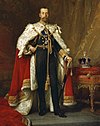| Revision as of 04:10, 3 May 2010 editRaul654 (talk | contribs)70,896 editsNo edit summary← Previous edit | Revision as of 10:48, 3 May 2010 edit undoDrKay (talk | contribs)Autopatrolled, Administrators159,933 editsm amend linksNext edit → | ||
| Line 1: | Line 1: | ||
| <div style="float:left;margin:0.5em 0.9em 0.4em 0;">]</div> | <div style="float:left;margin:0.5em 0.9em 0.4em 0;">]</div> | ||
| ''']''' (1865–1936) was ] of the United Kingdom and the British ]s, and ], from 6 May 1910 through ] until his death in 1936. He was the first |
''']''' (1865–1936) was ] and the British ]s, and ], from 6 May 1910 through ] until his death in 1936. He was the first British monarch of the ], which he created from the British branch of the German ]. From the age of twelve George served in the ], but upon the unexpected death of his elder brother, ], he became heir to the throne and married his brother's fiancée, ]. Although they occasionally toured the ], George preferred to stay at home with his stamp collection and lived what later biographers would consider a dull life because of its conventionality. George became King-Emperor in 1910 on the death of his father, ]. During World War I he relinquished all German titles and styles on behalf of his relatives who were British subjects, and changed the name of the royal house from Saxe-Coburg and Gotha to Windsor. During his reign, the ] separated the crown so that George ruled the ]s as separate kingdoms, preparing the way for the future development of the ]. His reign also witnessed the rise of ], ], ], ], and the first ] ministry. (''']''') | ||
| Recently featured: ] – ] – ] | Recently featured: ] – ] – ] | ||
Revision as of 10:48, 3 May 2010

George V (1865–1936) was King of the United Kingdom and the British Dominions, and Emperor of India, from 6 May 1910 through World War I until his death in 1936. He was the first British monarch of the House of Windsor, which he created from the British branch of the German House of Saxe-Coburg and Gotha. From the age of twelve George served in the Royal Navy, but upon the unexpected death of his elder brother, Prince Albert Victor, Duke of Clarence and Avondale, he became heir to the throne and married his brother's fiancée, Mary of Teck. Although they occasionally toured the British Empire, George preferred to stay at home with his stamp collection and lived what later biographers would consider a dull life because of its conventionality. George became King-Emperor in 1910 on the death of his father, King Edward VII. During World War I he relinquished all German titles and styles on behalf of his relatives who were British subjects, and changed the name of the royal house from Saxe-Coburg and Gotha to Windsor. During his reign, the Statute of Westminster separated the crown so that George ruled the dominions as separate kingdoms, preparing the way for the future development of the Commonwealth of Nations. His reign also witnessed the rise of socialism, communism, fascism, Irish republicanism, and the first Labour ministry. (more...)
Recently featured: Sex Pistols – Bird – Karl Aloys zu Fürstenberg